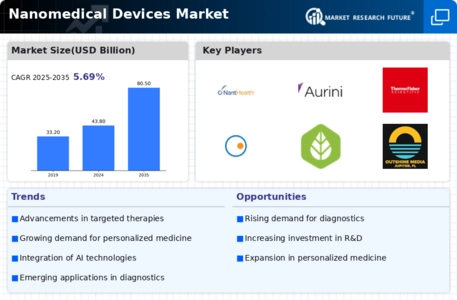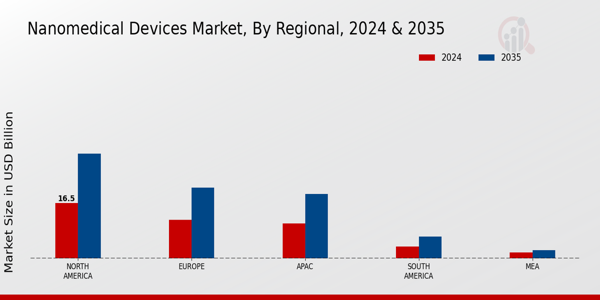Market Growth Projections
The Global Nanomedical Devices Market Industry is projected to experience substantial growth, with estimates suggesting a market size of 43.8 USD Billion in 2024 and a remarkable increase to 80.5 USD Billion by 2035. This growth trajectory indicates a robust demand for nanomedical devices, driven by advancements in technology and increasing healthcare needs. The anticipated CAGR of 5.69% from 2025 to 2035 reflects the industry's potential to innovate and expand, addressing the evolving challenges in healthcare. As the market matures, it is likely to attract further investment and research, fostering a cycle of continuous improvement and development.
Technological Advancements
The Global Nanomedical Devices Market Industry is experiencing rapid growth due to continuous technological advancements in nanotechnology. Innovations in materials science and engineering are enabling the development of more effective and targeted drug delivery systems. For instance, nanoparticles are being designed to improve the bioavailability of drugs, which enhances therapeutic outcomes. As a result, the market is projected to reach 43.8 USD Billion in 2024, driven by the increasing demand for precision medicine and personalized therapies. These advancements not only improve patient outcomes but also reduce side effects, making nanomedical devices a preferred choice in modern healthcare.
Regulatory Support and Frameworks
The Global Nanomedical Devices Market Industry benefits from evolving regulatory support and frameworks that facilitate the development and approval of nanotechnology-based medical devices. Regulatory bodies are increasingly recognizing the potential of nanomedical innovations and are establishing guidelines to ensure safety and efficacy. This supportive environment encourages investment and research, as companies are more likely to pursue the development of new nanomedical devices when clear regulatory pathways exist. As a result, the market is poised for growth, with projections indicating a significant increase in product approvals and market entries in the coming years.
Rising Prevalence of Chronic Diseases
The Global Nanomedical Devices Market Industry is significantly influenced by the rising prevalence of chronic diseases such as cancer, diabetes, and cardiovascular disorders. The need for innovative treatment options is paramount, as traditional therapies often fall short in efficacy and safety. Nanomedical devices, with their ability to target specific cells and deliver drugs at the molecular level, offer promising solutions. This trend is expected to contribute to the market's growth, with projections indicating a rise to 80.5 USD Billion by 2035. The integration of nanotechnology in medical devices is likely to enhance treatment efficacy and improve patient quality of life.
Growing Demand for Minimally Invasive Procedures
The Global Nanomedical Devices Market Industry is witnessing a surge in demand for minimally invasive procedures, driven by patient preferences for less traumatic treatment options. Nanomedical devices play a crucial role in facilitating these procedures by enabling precise interventions with reduced recovery times. Technologies such as nanobots and nanosensors are being developed to enhance surgical precision and monitoring capabilities. This shift towards minimally invasive techniques is expected to propel market growth, as healthcare providers increasingly adopt these innovative solutions to improve patient experiences and outcomes. The trend aligns with the broader movement towards patient-centered care in modern medicine.
Increased Investment in Research and Development
Investment in research and development within the Global Nanomedical Devices Market Industry is on the rise, as both public and private sectors recognize the potential of nanotechnology in healthcare. Governments and academic institutions are allocating substantial funds to explore new applications of nanomedical devices, which could lead to breakthroughs in diagnostics and therapeutics. This trend is likely to foster innovation and accelerate the commercialization of novel products. As a result, the industry is anticipated to grow at a CAGR of 5.69% from 2025 to 2035, reflecting the commitment to advancing nanomedical technologies and improving healthcare outcomes.




















